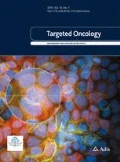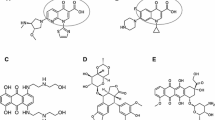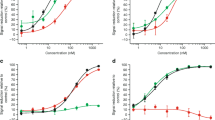Abstract
Background
The survival rate for acute myeloid leukemia remains unacceptably low, in large part owing to resistance to chemotherapy and high rates of relapse. There is an urgent need to develop new therapeutic modalities, in particular such that are tolerated by patients over the age of 60 years, who form the bulk of new acute myeloid leukemia diagnoses. Vosaroxin (SNS-595), a second-generation topoisomerase II inhibitor and DNA intercalating agent, shows promising preclinical and clinical activity against acute myeloid leukemia. Venetoclax (ABT-199), a selective Bcl-2 inhibitor, was recently approved for the treatment of acute myeloid leukemia.
Objective
The objective of this study was to determine the anti-leukemic activity and the underlying molecular mechanisms for the combination of venetoclax and vosaroxin in acute myeloid leukemia cell lines and primary patient samples ex vivo.
Patients and Methods
Using both acute myeloid leukemia cell lines and primary patient samples, annexin V/propidium iodide staining and flow cytometry analyses were used to quantify apoptosis induced by venetoclax or vosaroxin, alone or in combination, with subsequent western blotting analyses to assess levels of Bcl-2 family proteins. Alkaline comet assays were performed to quantify DNA damage induced by the two agents and to determine the effect of venetoclax on DNA repair. Finally, colony-forming assays were conducted on normal human CD34+ cord blood cells and primary acute myeloid leukemia patient samples to determine the effect of venetoclax and vosaroxin on normal hematopoietic and leukemic progenitor cells.
Results
We found that venetoclax and vosaroxin synergistically induced apoptosis in multiple acute myeloid leukemia cell lines. Although vosaroxin could partially abrogate the increase of Mcl-1 protein induced by venetoclax, it could not abrogate the increased binding of Bim to Mcl-1 induced by venetoclax. Cooperative induction of DNA damage occurred within 8 h of treatment with venetoclax plus vosaroxin. Moreover, repair of DNA damage induced by vosaroxin was significantly attenuated by venetoclax. The combination also synergistically induced apoptosis in primary acute myeloid leukemia patient samples and significantly reduced the colony formation capacity of acute myeloid leukemia progenitor cells, while sparing normal hematopoietic progenitor cells.
Conclusions
Vosaroxin and venetoclax synergistically induce apoptosis in acute myeloid leukemia cells and cooperatively target acute myeloid leukemia progenitor cells while sparing normal hematopoietic progenitor cells. Our results support the clinical testing of vosaroxin in combination with venetoclax for treating patients with acute myeloid leukemia, especially in the elderly population.








Similar content being viewed by others
References
Marcucci G, Haferlach T, Dohner H. Molecular genetics of adult acute myeloid leukemia: prognostic and therapeutic implications. J Clin Oncol. 2011;29(5):475–86.
Siegel RL, Miller KD, Jemal A. Cancer statistics, 2018. CA Cancer J Clin. 2018;68(1):7–30.
Short NJ, Rytting ME, Cortes JE. Acute myeloid leukaemia. Lancet. 2018;392(10147):593–606.
Ravandi F, Ritchie EK, Sayar H, Lancet JE, Craig MD, Vey N, et al. Vosaroxin plus cytarabine versus placebo plus cytarabine in patients with first relapsed or refractory acute myeloid leukaemia (VALOR): a randomised, controlled, double-blind, multinational, phase 3 study. Lancet Oncol. 2015;16(9):1025–36.
Ravandi F, Ritchie EK, Sayar H, Lancet JE, Craig M, Vey N, et al. Durable overall survival benefit in patients ≥ 60 years with relapsed or refractory AML treated with vosaroxin/cytarabine vs placebo/cytarabine: updated results from the Valor Trial. Blood. 2016;128(22):903.
Dennis M, Russell N, Hills RK, Hemmaway C, Panoskaltsis N, McMullin MF, et al. Vosaroxin and vosaroxin plus low-dose Ara-C (LDAC) vs low-dose Ara-C alone in older patients with acute myeloid leukemia. Blood. 2015;125(19):2923–32.
Daver N, Kantarjian H, Garcia-Manero G, Jabbour E, Borthakur G, Brandt M, et al. Vosaroxin in combination with decitabine in newly diagnosed older patients with acute myeloid leukemia or high-risk myelodysplastic syndrome. Haematologica. 2017;102(10):1709–17.
Knight T, Luedtke D, Edwards H, Taub JW, Ge Y. A delicate balance: the BCL-2 family and its role in apoptosis, oncogenesis, and cancer therapeutics. Biochem Pharmacol. 2019;162:250–61.
Konopleva M, Pollyea DA, Potluri J, Chyla B, Hogdal L, Busman T, et al. Efficacy and biological correlates of response in a phase II study of venetoclax monotherapy in patients with acute myelogenous leukemia. Cancer Discov. 2016;6(10):1106–17.
Niu XJ, Zhao JY, Ma J, Xie CZ, Edwards H, Wang G, et al. Binding of released Bim to Mcl-1 is a mechanism of intrinsic resistance to ABT-199 which can be overcome by combination with daunorubicin or cytarabine in AML cells. Clin Cancer Res. 2016;22(17):4440–51.
Luedtke DA, Niu X, Pan Y, Zhao J, Liu S, Edwards H, et al. Inhibition of Mcl-1 enhances cell death induced by the Bcl-2-selective inhibitor ABT-199 in acute myeloid leukemia cells. Signal Transduct Target Ther. 2017;2:17012.
Xie C, Edwards H, Caldwell JT, Wang G, Taub JW, Ge Y. Obatoclax potentiates the cytotoxic effect of cytarabine on acute myeloid leukemia cells by enhancing DNA damage. Mol Oncol. 2015;9(2):409–21.
Niu X, Wang G, Wang Y, Caldwell JT, Edwards H, Xie C, et al. Acute myeloid leukemia cells harboring MLL fusion genes or with the acute promyelocytic leukemia phenotype are sensitive to the Bcl-2-selective inhibitor ABT-199. Leukemia. 2014;28(7):1557–60.
Su YW, Li XY, Ma J, Zhao JY, Liu S, Wang G, et al. Targeting PI3K, mTOR, ERK, and Bcl-2 signaling network shows superior antileukemic activity against AML ex vivo. Biochem Pharmacol. 2018;148:13–26.
Uphoff CC, Drexler HG. Detection of mycoplasma contaminations. Methods Mol Biol. 2005;290:13–23.
Quentmeier H, Zaborski M, Drexler HG. The human bladder carcinoma cell line 5637 constitutively secretes functional cytokines. Leuk Res. 1997;21(4):343–50.
Ma J, Li XY, Su YW, Zhao JY, Luedtke DA, Epshteyn V, et al. Mechanisms responsible for the synergistic antileukemic interactions between ATR inhibition and cytarabine in acute myeloid leukemia cells. Sci Rep. 2017;7:41950.
Xie CZ, Edwards H, Xu XL, Zhou H, Buck SA, Stout ML, et al. Mechanisms of synergistic antileukemic interactions between valproic acid and cytarabine in pediatric acute myeloid leukemia. Clin Cancer Res. 2010;16(22):5499–510.
Edwards H, Xie CZ, LaFiura KM, Dombkowski AA, Buck SA, Boerner JL, et al. RUNX1 regulates phosphoinositide 3-kinase/AKT pathway: role in chemotherapy sensitivity in acute megakaryocytic leukemia. Blood. 2009;114(13):2744–52.
Ge YB, Stout ML, Tatman DA, Jensen TL, Buck SA, Thomas RL, et al. GATA1, cytidine deaminase, and the high cure rate of Down syndrome children with acute megakaryocytic leukemia. J Natl Cancer. 2005;97(3):226–31.
Xie CZ, Drenberg C, Edwards H, Caldwell JY, Chen W, Inaba H, et al. Panobinostat enhances cytarabine and daunorubicin sensitivities in AML cells through suppressing the expression of BRCA1, CHK1, and Rad51. PLoS ONE. 2013;8(11):e79106.
Chou TC. Theoretical basis, experimental design, and computerized simulation of synergism and antagonism in drug combination studies. Pharmacol Rev. 2006;58(3):621–81.
DiNardo CD, Pratz K, Pullarkat V, Jonas BA, Arellano M, Becker PS, et al. Venetoclax combined with decitabine or azacitidine in treatment-naive, elderly patients with acute myeloid leukemia. Blood. 2019;133(1):7–17.
Wei A, Strickland SA, Roboz GJ, Hou JZ, Fiedler W, Lin TL, et al. Safety and efficacy of venetoclax plus low-dose cytarabine in treatment-naive patients aged ≥ 65 years with acute myeloid leukemia. Blood. 2016;128(22):102.
Creutzig U, Zimmermann M, Reinhardt D, Rasche M, von Neuhoff C, Alpermann T, et al. Changes in cytogenetics and molecular genetics in acute myeloid leukemia from childhood to adult age groups. Cancer. 2016;122(24):3821–30.
Zhao JY, Niu XJ, Li XY, Edwards H, Wang G, Wang Y, et al. Inhibition of CHK1 enhances cell death induced by the Bcl-2-selective inhibitor ABT-199 in acute myeloid leukemia cells. Oncotarget. 2016;7(23):34785–99.
Xiufeng Z, Haijun Z, Silei B, Manman D, Yong Z, Lian Y, et al. Co-operation of ABT-199 and gemcitabine in impeding DNA damage repair and inducing cell apoptosis for synergistic therapy of T-cell acute lymphoblastic leukemia. Anticancer Drugs. 2019;30(2):138–48.
Laulier C, Lopez BS. The secret life of Bcl-2: apoptosis-independent inhibition of DNA repair by Bcl-2 family members. Mutat Res. 2012;751(2):247–57.
Drexler HG, Fombonne S, Matsuo Y, Hu ZB, Hamaguchi H, Uphoff CC. p53 alterations in human leukemia–lymphoma cell lines: in vitroartifact or prerequisite for cell immortalization? Leukemia. 2000;14(1):198–206.
Sugimoto K, Toyoshima H, Sakai R, Miyagawa K, Hagiwara K, Ishikawa F, et al. Frequent mutations in the p53 gene in human myeloid leukemia cell lines. Blood. 1992;79(9):2378–83.
Grundy M, Seedhouse C, Jones T, Elmi L, Hall M, Graham A, et al. Predicting effective pro-apoptotic anti-leukaemic drug combinations using co-operative dynamic BH3 profiling. PLoS ONE. 2018;13(1):e0190682.
Kotschy A, Szlavik Z, Murray J, Davidson J, Maragno AL, Le Toumelin-Braizat G, et al. The MCL1 inhibitor S63845 is tolerable and effective in diverse cancer models. Nature. 2016;538(7626):477–82.
Bannister T, Koenig M, He Y, Mishra J, Spicer T, Minond D, et al. ML311: a small molecule that potently and selectively disrupts the protein-protein interaction of Mcl-1 and Bim: a probe for studying lymphoid tumorigenesis, probe reports from the NIH Molecular Libraries Program. Bethesda: National Center for Biotechnology Information; 2010.
Li Z, He S, Look AT. The MCL1-specific inhibitor S63845 acts synergistically with venetoclax/ABT-199 to induce apoptosis in T-cell acute lymphoblastic leukemia cells. Leukemia. 2019;33(1):262–6.
Souers AJ, Leverson JD, Boghaert ER, Ackler SL, Catron ND, Chen J, et al. EABT-199, a potent and selective BCL-2 inhibitor, achieves antitumor activity while sparing platelets. Nat Med. 2013;19(2):202–8.
Kipps TJ, Eradat H, Grosicki S, Catalano J, Cosolo W, Dyagil IS, et al. A phase 2 study of the BH3 mimetic BCL2 inhibitor navitoclax (ABT-263) with or without rituximab, in previously untreated B-cell chronic lymphocytic leukemia. Leuk Lymphoma. 2015;56(10):2826–33.
Roberts AW, Seymour JF, Brown JR, Wierda WG, Kipps TJ, Khaw SL, et al. Substantial susceptibility of chronic lymphocytic leukemia to BCL2 inhibition: results of a phase I study of navitoclax in patients with relapsed or refractory disease. J Clin Oncol. 2012;30(5):488–96.
Wilson WH, O’Connor OA, Czuczman MA, LaCasce AS, Gerecitano JF, Leonard JP, et al. Navitoclax, a targeted high-affinity inhibitor of BCL-2, in lymphoid malignancies: a phase 1 dose-escalation study of safety, pharmacokinetics, pharmacodynamics, and antitumour activity. Lancet Oncol. 2010;11(12):1149–59.
Author information
Authors and Affiliations
Contributions
YG and LS designed the project and directed the study. FL and YS performed the experiments, data analysis, and interpretation. TK drafted the manuscript. FL, HE, and YG edited the manuscript. HL and YW provided the primary AML patient samples and participated in the coordination of the study. JWT, GW, HE, and YG participated in the data analysis and interpretation. All authors read and approved the final manuscript.
Corresponding authors
Ethics declarations
Funding
This study was supported by Jilin University, Changchun, China, the Barbara Ann Karmanos Cancer Institute, Wayne State University School of Medicine, and by grants from the National Natural Science Foundation of China (NSFC 31671438 and NSFC 31471295), National Key Research and Development Program of China (2017YFC1702100), Hyundai Hope on Wheels, LaFontaine Family/U Can-Cer Vive Foundation, Kids Without Cancer, Children’s Hospital of Michigan Foundation, Decerchio/Guisewite Family, Justin’s Gift, Elana Fund, Ginopolis/Karmanos Endowment, and the Ring Screw Textron Endowed Chair for Pediatric Cancer Research. The funders had no role in the study design, data collection, analysis and interpretation of data, decision to publish, or preparation of the manuscript.
Conflict of interest
Fangbing Liu, Tristan Knight, Yongwei Su, Holly Edwards, Guan Wang, Yue Wang, Jeffrey W. Taub, Hai Lin, Liwei Sun, and Yubin Ge have no conflicts of interest that are directly relevant to the contents of this article.
Electronic supplementary material
Below is the link to the electronic supplementary material.
Rights and permissions
About this article
Cite this article
Liu, F., Knight, T., Su, Y. et al. Venetoclax Synergistically Enhances the Anti-leukemic Activity of Vosaroxin Against Acute Myeloid Leukemia Cells Ex Vivo. Targ Oncol 14, 351–364 (2019). https://doi.org/10.1007/s11523-019-00638-4
Published:
Issue Date:
DOI: https://doi.org/10.1007/s11523-019-00638-4




